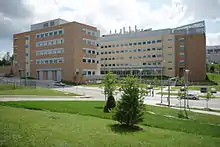School
A school is an educational environment where children go to learn from a teacher. Topics such as reading, writing, and mathematics are central to education. Although many kids hate school they have to go as it is a law.


.jpg.webp)
.jpg.webp)
Most of a student's time is spent in a classroom. This is where 10 to 30 people sit to take part in educational discussion. In the United States, the average number of students per classroom in primary schools is 23.1.[1]
The term "school" is used for many educational environments--particularly in North America. There are different types of schools: elementary schools (primary in the UK), middle schools (secondary in the UK), and so on.
In many places around the world, children must go to school for a certain number of years. Learning may take place in the classroom, in outside environments or on visits to other places. Colleges and universities are places to learn for students over 17 or 18 years of age.[2] Vocational schools teach skills people need for jobs.
Some people attend school longer than others. This is because some jobs require more training than others, like for example becoming a doctor takes about 10-14 years of education.[3] For young children, one teacher may teach all subjects. Teachers for older students are more specialized, and they only teach a few subjects. Common subjects taught include science, arts such as music, humanities, like geography and history, and languages.
Children with mental health problems, and problems such as autism and other conditions, usually do not go to regular schools. These children are given other ways to get schooling, like special schools. There also are special schools which teach things which regular schools do not.
Graduate schools are in universities. They are for students who have graduated with a first degree from colleges and universities. The aim is to offer Masters and PhD courses to the best students.
Schools for boys and schools for girls
Education for all is quite modern. In England, for example, most people could not read or write, even early in the 19th century. We know this because when they got married, those who could not write put an 'X' on the certificate, and someone else wrote their name. Widespread education for reading and writing began in the 19th century.
Long ago, most schools were run by religious denominations. That is because clerics were once almost the only people who were literate: they were able to read and write.
In most countries boys were taught differently to girls, and separately from girls. Today, many countries have schools which accept both boys and girls, though some places still have separate schools for girls. Some parents believe that girls do better in single-sex schools.
School as a place to learn for life
In many parts of the world, schools also help children learn things about life.
- In school, pupils develop their personality.
- Schools teach pupils about religion and ethics.
- Schools help children recognise socially accepted norms and behaviour.
Pedagogy is the science of teaching children. Different schools use different ways of teaching. There is quite a lot of disagreement about what and how students should be taught.[4][5] Many countries solve this by allowing different types of school, so parents and children have some choice. Choices may include home education, which is a controversial idea.
Comprehensive schools
A British term which means roughly "a secondary school for all children in a particular neighbourhood". It includes the idea of taking both boys and girls in one school, and the idea of taking children of all abilities. In practice it has many of the problems which are endemic in American high schools. Among its main faults are said to be: putting girls and boys together at the sensitive time of puberty, and the behavioural problems associated with having such a wide range of young people in a large school. Evidence for lowered standards for examinations are disputed, but widely believed to be true.[4]
References
- Rampell, Catherine (2009-09-11). "Class size around the world". Economix Blog. Retrieved 2020-12-05.
- In some countries they are also informally called "schools".
- "How long does it take to become a doctor?". Indeed Career Guide. Archived from the original on 2020-12-05. Retrieved 2020-12-05.
- Woodhead, Chris 2002. Class war: the state of British education. London: Little Brown. ISBN 0-316-85997-4 The author was a former chief inspector of schools.
- Cosslett, Rhiannon Lucy. Schools don’t prepare children for life. Here’s the education they really need.